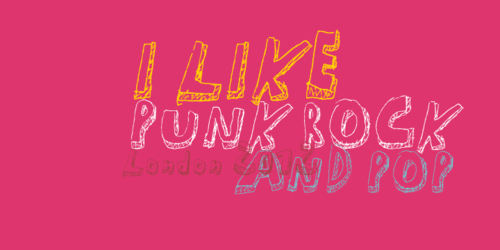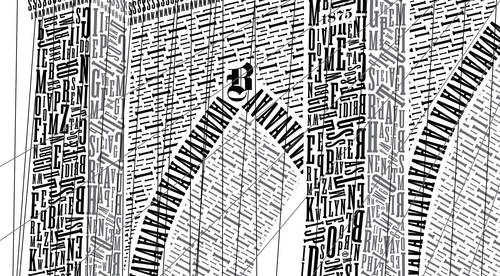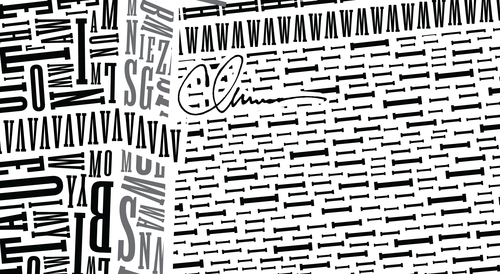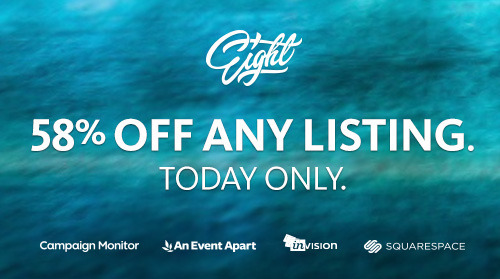Cameron Moll's Blog, page 3
January 15, 2014
“The problem is that we don’t have the right words to talk about this stuff.”
Jason Santa Maria, writing for The Pastry Box:
We talk all the time on our personal and periodical sites about the latest techniques for design, but how often do we break down new designs? I mean really discuss them, not just add them to a gallery of notable sites.
Aesthetics are just one lens we can use to look at web design. Culture, time, place, and technology are others. Some websites look and act the way they do because of the state of technology during the time they were made. The landscape of architecture was changed by the invention of steel, just as the landscape of web was change by Flash, CSS, mobile phones, and Retina screens….
If work like Bowman’s WIRED.com website was so wonderful, does the fact that it isn’t suited to today’s web diminish that fact?
And later,
The problem is that we don’t have the right words to talk about this stuff, let alone the right context to find common ground for real discussion inside our industry or the folks just outside it. If our eyes are only attuned to the latest shiny thing, we can’t possibly understand anything of influence or consequence.
For as long as I’ve known Jason, he has championed more thoughtful discussion in, about, and surrounding web design. I hope he never gives up the fight, as user interface design is becoming (if not already) the most ubiquitous form of design in our time.
December 11, 2013
“Food, please.”
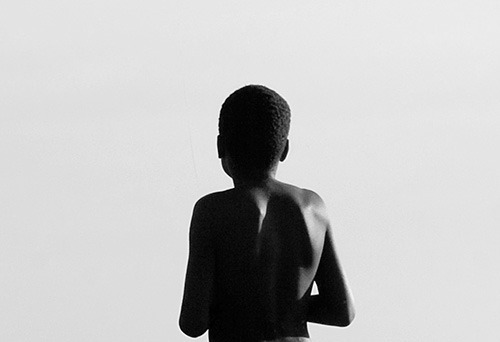
As we left our hotel in Addis Ababa the final morning of an amazing trip to Ethiopia with charity: water and Will Smith, we headed to the local market. Goods of every kind were offered: artwork, scarves, jewelry, clothing, housewares, and so on.
At the market, a boy, probably 8 or 9 years old, began following us. The right side of his face was badly disfigured, as if it had been burned by fire. He wasn’t shy and immediately starting asking for things in very broken English. Money was the first request, and we hesitated to hand any out, as we were informed that doing so had the potential to create chaos in a busy marketplace.
I had on a small backpack, and soon this young boy began pointing to it. In broken but comprehensible English, he simply said, “Food, please.”
The first few times he said it, I couldn’t figure out why he was thinking I had food. And then I realized that just before we left the car to tour the market, I had placed a large, clear ziplock bag with several food items in it—nuts, granola bars, beef jerky—in the outer mesh pocket of the bag. It was easily visible to anyone.
“Food, please” he continued. “Food, please.”
Again I was hesitant to offer any, as it had the potential to create a swarm of children around us if not done carefully. At this point, we were done shopping and needed to leave for the airport. He continued to follow me. Suzanne and I returned to the car. I was stuck in a quandary. I knew if I left that little boy without giving him something, my conscience would haunt me unceasingly in the coming days and weeks.
Literally as our driver began to pull away, I quickly removed the bag from my backpack, rolled down the window, and handed the food to that young boy. By now he had a companion with him, about the same age, and probably just as famished. As soon as he perceived I was handing the bag to him, he snatched it as quickly as he could.
As we drove off, I watched the two of them run to an alley in the marketplace. They disappeared behind one of the stores, undoubtedly to devour their gain. I had a difficult time holding back the tears as I contemplated what had just taken place. How grateful I am, as is my conscience, that I didn’t stay my hand that day.
Our trip to Ethiopia could not have been filled with more insight into the lives of people in Tigray, more experiences to be touched and affected by the people of the area, and more opportunities to see just how blessed many of us are.
But there is something even more essential than food; even more vital to the famished. It is water.
We’re so close to surpassing $100,000 raised for clean water. I come to you with hat in hand, requesting your help one last time. This Monday I’ll be attending the 2013 charity: ball. How incredible it would be to personally thank Scott Harrison on your behalf for allowing us to participate in the global fight for clean, safe drinking water.
I’ve just contributed another $500 of my personal funds to our campaign. If you can do the same, please join me. If not, any amount you can afford will do amazing things for clean water.
Merry Christmas to all, and may clean water be one of the greatest gifts we give this year.
December 9, 2013
A suitable alternative to American Apparel
It’s been 4 years since sharing my concerns regarding American Apparel’s suggestive advertising. My views remain unchanged.
Occasionally I’m asked about alternatives from those who, like me, print T-shirts from time to time. My response is generally this: American Apparel makes a great shirt, no doubt about it. They fit well, they look great, and they’re manufactured in the USA.
It’s tough to find a substitute. I’ve ordered numerous blanks from competing manufacturers over the years, and I’ve struggled to find a shirt I was satisfied with. Regardless, I’ll gladly wear substitutes if it means my money isn’t supporting AA’s advertising efforts.
However, I think I’ve finally found a suitable alternative.
Last year I ordered a couple shirts from a site that many of you may recognize*. The look and fit were outstanding. I ordered a third. And then a fourth. I’ve worn these shirts many times since.
They were kind enough to share their secret with me: Next Level Apparel. In every aspect I find them to be a worthy competitor to American Apparel, save one:
Our fabrics are produced in China and the USA. Garments are assembled in China, Mexico, and Central America.
This is a definitely a trade-off, and a significant one. But it’s one I’m willing to make, and I’m appreciative of the efforts being made to detail—and hopefully improve—factory conditions outside the U.S. (Don’t miss NPR’s “Planet Money Makes a T-Shirt” series.)
While we’re at it, I’d be ashamed if I didn’t encourage you to pick up a copy of the Authentic Jobs ‘EIGHT’ shirt, printed on Next Level tees. You can also order a low-cost blank instead if you’d like to try on their stuff.
Give it a shot. I’m guessing you fall in like with Next Level, too.
* I’ve not requested permission to share their secret, so I’ve left them unnamed.
December 6, 2013
“It’s not as dramatic, terrible, and exhausting as most glamorized stories would have you believe.”
Garrett Dimon, on building a business:
Whenever people talk about starting businesses, one of the most common deterrents people bring up is having a family to support. While being cautious and making sure not to put your family at risk is important, this fear assumes that there are only downsides. That couldn’t be further from the truth. I’m in my mid-thirties, married, and we have a two and a half year old daughter and a mortgage. We’re also a single-income family as my wife takes care of our daughter full-time….
The biggest hurdle here is to stop thinking of launching a business as binary and imagining quitting your job on a whim one day. With that approach, your fears are entirely justified unless you have a huge savings account that you can afford to risk.
In a similar vein, ‘timmm’ provides the following advice in his reply to this startup story:
The wrong way is by taking out credit, quitting your day job prematurely, spending other people’s money, leveraging your family’s future, and jeopardizing your mental/emotional well being.
The right way is by creating a system that is robust; a job to pay the bills, allocating some amount of free time to working on the business, focusing on sustainability, refusal to take shortcuts, spending your own money (when it’s needed) and not being in such a fricken hurry to get somewhere.
You do it properly by slowly gaining mastery in your business until when the time comes you’ve EARNED the right to quit your day job and go full time for yourself.
And that’s precisely the path I’ve followed with Authentic Jobs. Eight years later, and only the latter half of those years being full-time, I’m pretty happy with how things have turned out.
December 5, 2013
Matí’s gift for Father’s Day: A hand-drawn font.
Ale Paul, penning the most awesome font description ever:
Up to this point, my Father’s Day gift history was nothing unusual. Books, socks, hand-painted wooden spoons, the kind of thing any father would expect from his pre-teen son. So you can understand when I say I was bracing myself to fake excitement at my son’s present.
But this Father’s Day was special. I didn’t have to fake excitement. I was in fact excited beyond my own belief. Matí’s handmade present was a complete alphabet drawn on an A4 paper.
Purchased.
November 21, 2013
What Screens Want
A screen doesn’t care what it shows any more than a sheet of paper cares what’s printed on it. Screens are aesthetically neutral, so the looks of things are not a part of their grain. Sorry, internet. If you want to make something look flat, go for it. There are plenty of reasons to do so. But you shouldn’t say you made things look a certain way because the screen cared one way or the other.
Don’t stick around here. Frank’s microsite designed for his presentation at Build 2013, from which the above quote was extracted, needs to be seen to be fully appreciated.
November 8, 2013
Q & A from Front-End Design Conference
Dan and Cherrie Denney, two of the nicest people I’ve ever met, run one of the nicest conferences in our industry. They recently sent me a lovely gift in the mail.
Sean McCabe, known by many as Sean Wes, captured sketch notes during my talk earlier this year:

Below is his (abbreviated) transcript of my remarks. Video from the full presentation will be posted soon.
How do you balance everything?
I don’t. I prioritize. Not everything has to be top priority all the time. Long term goals help balance and shift short term priorities.
What’s the most significant mistake you’ve made?
My worst mistakes are the ones I didn’t learn anything from. Ask yourself: What can you do better?
How can I make a name for myself?
Write. Write passionately about something—regardless of whether you feel like you’re qualified. Write consistently & passionately.
What advice would you give to someone wanting to break into our field?
1) Copy. Imitate. “Good artists copy, great artists steal.” As we develop our own style, we can integrate some uniqueness into that. 2) Push yourself. Try things you don’t know how to do. 3) Understand and learn hierarchy. It is so fundamental to everything that we do. It’s often overlooked how important that one principle is.
October 21, 2013
What the Designer Ought to Be
Milton Glaser, in a presentation to the AIGA NY chapter:
While I was in the doctor’s office I noticed a document on his wall called ‘What A Surgeon Ought to Be’ written in the 14th century. I’ve changed a word or two but it seems like good advice for our profession.
What the Designer Ought to Be: Let the designer be bold in all sure things, and fearful in dangerous things; let him avoid all faulty treatments and practices. He ought to be gracious to the client, considerate to his associates, cautious in his prognostications. Let him be modest, dignified, gentle, pitiful, and merciful; not covetous nor an extortionist of money; but rather let his reward be according to his work, to the means of the client, to the quality of the issue, and to his own dignity.
October 11, 2013
Now available: Brooklyn Bridge letterpress poster
Three years in the making, and my Brooklyn Bridge letterpress poster is finally available. Reserve your copy on Kickstarter.
I’ll pen more about the project at a later date. But for the time being, I’ll allow the Kickstarter video and photos to do the talking.
September 25, 2013
Authentic Jobs: 58% off listings, today only.
September 25th (today) is one of the most enjoyable business days of the year for me. It’s a humble reminder that my little company, Authentic Jobs, has completed another successful year of connecting great companies with talented individuals. Plus, I get offer all of you a sizable discount that increases by 1% every year.
Enjoy 58% off any job posting, today only. Sale expires tonight at midnight.
Cameron Moll's Blog
- Cameron Moll's profile
- 4 followers


